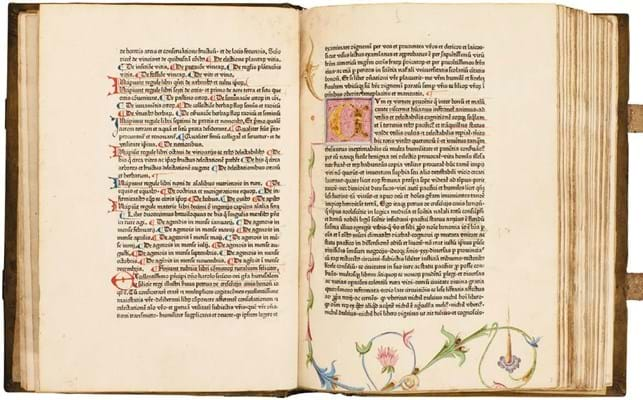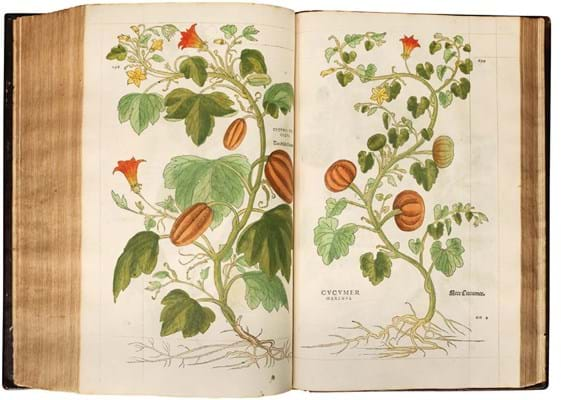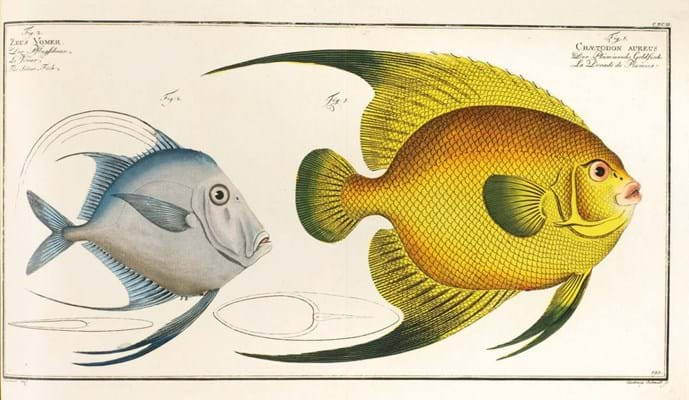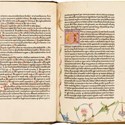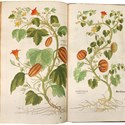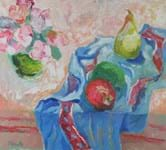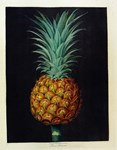The odd firearm, a crossbow, and even snuffboxes decorated with hunting scenes were also to be found in the catalogue, but this was an unusual and very mixed collection and it was not always those works which produced the higher bids.
Early printed books and atlases also made a significant contribution to the premium-inclusive £2.2m sale total, but these will feature in later reports.
Hunting
Promoted as the first printed book on agriculture was a 1471, Augsburg first edition of the Opus ruralium commodorum, a well-known practical manual compiled in the early 14th century by a retired lawyer, Pietro de’ Crescenzi.
Inspired by his experiences on his Villa del’Olmo estate and drawing for advice on estate management from classical sources, this work is also renowned as the first printed book to feature the subject of hunting.
In a period binding of reversed calf over wooden boards and incorporating a couple of illuminated initials among the coloured decorations, as well as containing a contemporary manuscript index, it sold way over estimate at a record £150,000.
Thirty years ago, as part of the Sotheby’s Monaco sale of the superb hunting library of Marcel Jeanson, it had sold for Fr170,000 (around £16,000).
Estimated at £30,000- 40,000, a woodcut illustrated edition of the same work printed c.1490-95 by Peter Drach of Speyer, however, failed to sell.
Valued at £5000-7000 but sold for £65,000 was a sumptuously produced and finely bound calligraphic manuscript hunt book, dated 1670. It principally records the hunting successes of Johan Georg II, Elector of Saxony (1613-80), but details of the achievements of other members of his family are also included, among them those of Johann Georg IV, who at age five bagged three badgers and a hamster.
There were plenty of job lots of French and German text books on hunting but individual highlights include a 1754, Bayreuth reprint of a 1568, Poitiers edition of Jacques du Fouilloux’s La Venerie, which made £22,000. The engravings are based on the 16th century originals, but with costumes and even the designs of hunting horns updated.
Sold for £4000 was an album amicorum compiled in the latter part of the 18th century by one Christian Kress. Among 27 watercolour and gouache illustrations accompanying the entries are many hunting scenes – one of which is pictured below.
Once part of the library of the renowned bibliographer of hunting books, CFGR Schwerdt, it made £26 in his 1946 sale at Sotheby’s.
Sold for £7200 was an oblong quarto album of woodcut hunting and related scenes by Tobias Stimmer and Christoph Murer, published in Strassburg in 1605. Each is accompanied by a verse caption and the 70 full-page cuts feature stag, wolf and boar hunting scenes, as well as others showing the making of pits and traps, the rearing and training of hounds, and so on. It sold for £7200.
Falconry
Works in this category included a 1596 first of a classic treatise produced in the mid-13th century by Frederick II of Germany, who on his return from a crusade had brought back with him several Middle Eastern falconers and their birds. Containing the double-page woodcut shown below, this copy in 17th century calf made £7000 at Sotheby’s.

Double-page woodcut from a 1596 first of a classic treatise on falconry produced in the mid-13th century by Frederick II of Germany that sold for £7000 at Sotheby’s.
Ornithology
Bound in contemporary French red morocco gilt by Bozerian, one of 200 folio copies of the 1800-02first edition of Audebert & Viellot’s Oiseaux dores ou a reflets metalliques sold at £22,000. The 190 etched plates by Audebert were all printed in gold and colours by Langlois.
Ten years ago Christie’s sold for £35,000 the ex-Schaefer/Arcadian Library copy that had once belonged to Franz-Joseph of Austria.
The most celebrated copy, however, is one formerly in the library of the Duchesse de Berry that in 1999 made two auction appearances and a third just five years later.
One of a very few special gold printed and heightened copies and in a contemporary armorial binding by Simier, it made $70,000 at Sotheby’s New York in April 1999, but just six months later was bid to £160,000 at Christie’s in London.
Then in 2004 it was offered by Bonhams and again made £160,000.
Botany
The most expensive work at Sotheby’s was a finely coloured copy of a very famous and much admired herbal, a 1542 first of the physician and botanist Leonhard Fuchs’ De historia stirpium.
This is a work illustrated with more than 500 full-page woodcuts of plants that in many instances were cultivated in his own medicinal garden at Tübingen. All the plates in this copy exhibited period colour and the binding was a contemporary one of morocco gilt.
This copy sold at record £250,000, but it was only in June of this year that another example of this rare work was sold for SKr1.2m (£112,610) by Stockholms Auktionswerk, as reported in ATG No 2304.
Miscellany
A famous early work on fishes by Marcus Bloch, and a charming 16th century selection of natural history illustrations by a Dutch artist, Joris Hoefnagel, feature among the accompanying illustrations.
German artist
A group of 42 lots in the Sotheby’s sale, many of them multiples, featured the work of Elias Ridinger (1698-1767). A German artist, his speciality was the animal world and hunting scenes were a frequent theme.
Shown above is a rare example of Ridinger working in bold and bright watercolours rather than his more familiar ink and wash style. Depicting an elephant fighting with foxes or dogs, it sold at £6500.
Sold for a much higher than expected £17,000 was a rare copy of Ridinger’s last published work, a collection of 50 hand-coloured engraved illustrations of horses with text and titles in German and French that was printed in Augsburg in 1770.


